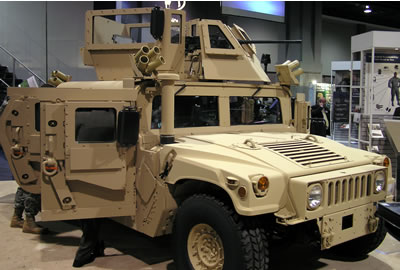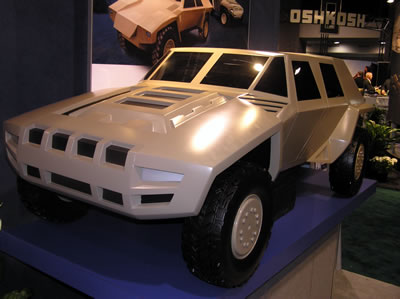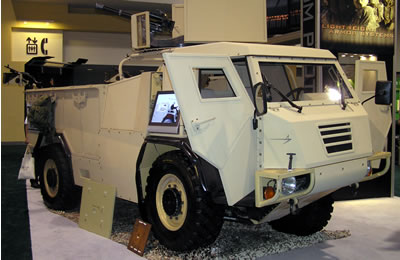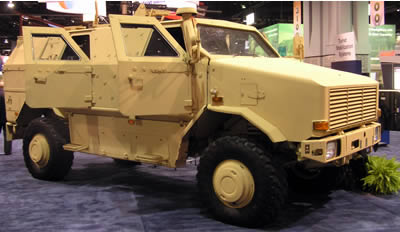The weight penalty of the armor is taking its toll in terms of decreased performance and maneuverability, increasing operating costs and accelerating the wear of up-armored vehicles. Therefore, the U.S. Army is seeking heavier, more powerful vehicles which could carry the extra load of the armor while maintaining sufficient load capacity for mission payload. This trend was evident at AUSA 2006, with the display of preliminary concept models of the JLTV shown by Oshkosh Trucks and General Dynamics, and the introduction of near-term armored trucks and utility vehicles, proposed to fulfill ad-hoc requirements, all adhering to the concepts prescribed by the pentagon’s Long Term Armoring Strategy (LTAS).
The latest version of the Up Armored Humvee was on display at Armor Holdings, demonstrating the latest armor add-ons, including a new armor kit, improved gunner’s protection kit (I-GPK) designed to defeat small-arms’ AP threats. It is fitted with rock-strike resistant transparent armor keeping the gunner protected while in weapon engagement posture. I-GPK is available as retrofit for M-1114 up-armored Humveesalready fitted with GPK. Four mount quad launchers are installed at the four corners of the vehicle, where they can screen all directions with smoke or non-lethal munitions. The vehicle can be fitted with air-conditioning system derived from an airborne system designed by Foster Miller. This air conditioning system supports up to five individual micro-cooling vests, reducing cabin temperature to less than 29C deg. (85 F). The system also supports the gunner, even with the turret hatch open.
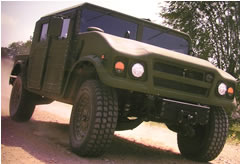 The Turkish Otokar Cobra light armored vehicle, based on the HMMWV chassis, was displayed by AM General, which also displayed the HMMWV successor – the Evolutionary Combat System (ECV II). This concept vehicle promises to take the current HMMWV to a higher level, retaining full payload capacity when armored. Armoring of the ECV II will adhere to the US Army Long Term Armoring Strategy (LTAS), providing the basic protection as an integral part of the vehicle’s structure. ECV II will be equipped with 250 hp engine, using JP8 fuel. For improved mobility and comfort the vehicle uses semi-active suspension, central tire inflation system and an integrated air conditioning system.
The Turkish Otokar Cobra light armored vehicle, based on the HMMWV chassis, was displayed by AM General, which also displayed the HMMWV successor – the Evolutionary Combat System (ECV II). This concept vehicle promises to take the current HMMWV to a higher level, retaining full payload capacity when armored. Armoring of the ECV II will adhere to the US Army Long Term Armoring Strategy (LTAS), providing the basic protection as an integral part of the vehicle’s structure. ECV II will be equipped with 250 hp engine, using JP8 fuel. For improved mobility and comfort the vehicle uses semi-active suspension, central tire inflation system and an integrated air conditioning system.
 Several versions of armored trucks were shown, including the FMTV, from Armor Holdings’ subsidiary Stewart Stevenson which displayed two new versions of the lightweight FMTV family of trucks. These included a new utility variant, based on the M1078 (LMTV) chassis, capable of carrying a payload of three tons with full armor, without degradation in vehicle’s performance, handling and mobility. Another vehicle demonstrated the “next generation” configuration for the FMTV armored cab. The new cabin improves visibility, safety, handling and comfort, while providing base level ballistic protection and prepared attachments and bolts for the add-on armor kits (B-kit).
Several versions of armored trucks were shown, including the FMTV, from Armor Holdings’ subsidiary Stewart Stevenson which displayed two new versions of the lightweight FMTV family of trucks. These included a new utility variant, based on the M1078 (LMTV) chassis, capable of carrying a payload of three tons with full armor, without degradation in vehicle’s performance, handling and mobility. Another vehicle demonstrated the “next generation” configuration for the FMTV armored cab. The new cabin improves visibility, safety, handling and comfort, while providing base level ballistic protection and prepared attachments and bolts for the add-on armor kits (B-kit).
Lockheed Martin’s is developing the new Lightweight Prime Mover (LMPW). The new all-terrain vehicle is designed to address US Marine Corps’ requirements for 120 tow vehicles for their new M777 155mm howitzers. This powerful, light vehicle can tow over 10,000 pounds (4.53 tons) of weight. It is transportable externally with MV-22 and CH-53. The company displayed the Proof of Concept Vehicle, shown with add-on armor suite developed by ArmorWorks. ArmorWroks offers especially lightweight version of the Ballistic Advantage armor kit, tailored for the Fast Attack Vehicle based on the G-Wagon from Mercedes Benz. The armor kit can be installed in the field within five hours, offering protection against 5.56mm and 7.62mm ball and AP ammunition, IEDs, artillery fragmentation and mine blasts.
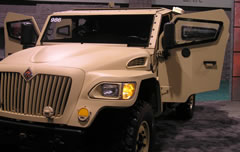 Similar armor kits are available for field installation on the HMMWV, FMTV and as add-on protection on M915 truck cabs. An armored version of the MXT-MV utility vehicle developed by International Truck and Engines, was unveiled here with an armor suite designed by Plasan Sasa, protecting the driver and passengers against all types of 7.62mm AP ammo, mines, and IED threats. Ceramic armor specialist Ceradyne presented here an add-on armor “B kit”, designed for the Mack Granite truck cab.
Similar armor kits are available for field installation on the HMMWV, FMTV and as add-on protection on M915 truck cabs. An armored version of the MXT-MV utility vehicle developed by International Truck and Engines, was unveiled here with an armor suite designed by Plasan Sasa, protecting the driver and passengers against all types of 7.62mm AP ammo, mines, and IED threats. Ceramic armor specialist Ceradyne presented here an add-on armor “B kit”, designed for the Mack Granite truck cab.
Physical protection for troops traveling in convoys could be provided by the Multi-purpose Troop Transport Carrier System (MTTCS) developed by Teledyne Brown Engineering and SAIC, to address military requirements for safe transport and rapid deployment of troops and fortifications. The basic shelter accommodates up to 10 persons and their associated gear while countering the ballistic threats of small-arms fire, up to and including 7.62 mm AP, and most fragmentation from Improvised Explosive Device (IED) blast threats. The MTTCS has been test proven by the Rapid Equipping Force (REF) at the U.S. Army Test and Evaluation Command, and has undergone combat operational evaluation under REF sponsorship in Iraq.

